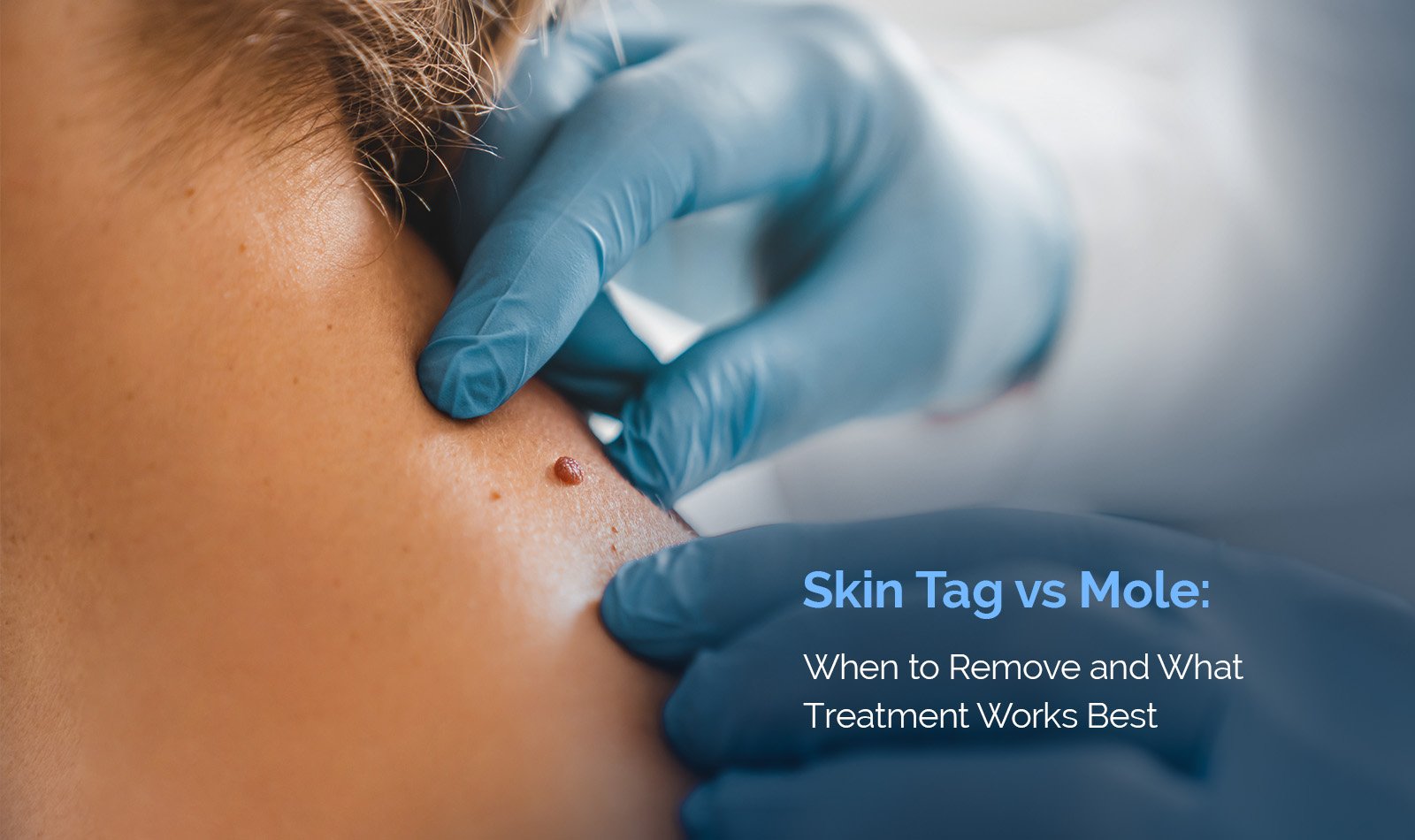Contents
Skin growth’s super normal; everybody’s got them. Most of the time, it’s no big deal. But you noticed a new bump or lump in your skin and wondered,“Uh, is this just a mole or skin tag?” Figuring out what you’re looking at is kinda important before you decide to ignore it or seek treatment.
In this blog, we’ll walk you through how to tell them apart and what you can actually do to get rid of them if you want.
Skin Tag Vs Mole
Skin Tag:
Skin tags, medically referred to as acrochordons, are primarily composed of adipose (fat) tissue, nerve elements, and bundles of collagen fibers.
Skin tags are soft growths that hang from the skin by a thin stalk. They match your skin tone or may be a little darker. They usually develop in the areas where your skin gets a lot of friction, like shirt collars, bra straps, or jewelry. They are most likely to develop in the following areas:
- neck
- armpits
- groin
- underneath breasts
- eyelids
Mole:
Moles are clusters of melanocytes, the pigment cells. They can be flat or raised and range in color from light brown to dark brown or black. It’s important to monitor moles for any notable changes. Specifically, the ABCDE criteria serve as a guideline: Asymmetry (one half doesn’t match the other), border irregularity (edges may be uneven or blurred), color variation (different shades or colors within the same mole), diameter (greater than that of a pencil eraser), and evolving (any change in size, shape, color, or symptoms over time). If a mole exhibits any of these warning signs, it warrants professional evaluation.
When Removal Makes Sense
You do not need to remove skin tags if they feel fine and do not bother you. The only time you really get to call in a dermatologist is if those things start getting snagged on your shirts, start bleeding, or start itching, or you do not recognize them.
For moles, removal is recommended if they exhibit any of the ABCDE warning signs (Asymmetry, Border irregularity, Color variation, Diameter greater than 6mm, or Evolving in appearance). Any noticeable change in a mole may indicate melanoma, and early detection is critical for effective intervention and improved outcomes.
Best Removal Options for Each
Dermatologists use different methods to remove skin growths safely.
Skin Tags Removal
- Freezing (cryotherapy) with liquid nitrogen is minimally painful and quick.
- Cutting off with surgical scissors or a scalpel works for larger tags.
- Heat (cauterization) or electrosurgery burns skin tags away in a controlled way.
Mole Removal
- Shave excision removes surface-level moles with minimal scarring.
- Surgical excision removes the entire mole with stitching, especially if deeper cells must go.
- Punch biopsies target deeper skin layers when removal and diagnosis are needed.
- Laser removal targets flat moles. Best for cosmetic cases. Not ideal for suspicious moles because it might delay diagnosis.
Avoid DIY Methods
The FDA warns against over-the-counter skin tag and mole removers. They are unapproved and may cause infection, scarring, or misdiagnosis of skin cancer. Home removal puts you at risk. Always see a dermatologist.
Dr Fehmida’s Expertise in Skin Growth Care
At Dr Fehmida’s clinic in Karachi you receive expert guidance. She examines your skin, confirms whether growths are skin tags or moles, and recommends the right treatment: cryotherapy, excision, laser, or biopsy when needed. You get safe removal, clear diagnosis, and advice that respects your skin’s health and look.
Comparison Table of Treatments
| Growth Type | When to Remove | Common Treatment Options | Diagnostic Benefit |
| Skin Tag | Causing irritation or concern | Cryotherapy, excision, cauterization | Rarely needed |
| Mole | Changing or suspicious | Shave, surgical excision, punch biopsy, laser (cosmetic only) | Essential if changes observed |
Take Charge of Your Skin Health
You deserve clear answers and safe treatment. Now you know how to spot the difference between a skin tag and a mole, as well as when it’s appropriate to consult a physician and which treatments are most effective, you’re better equipped to make informed decisions. If you need any further assistance or guidance, Dr. Fehmida will guide you through each decision with expertise and clarity.

